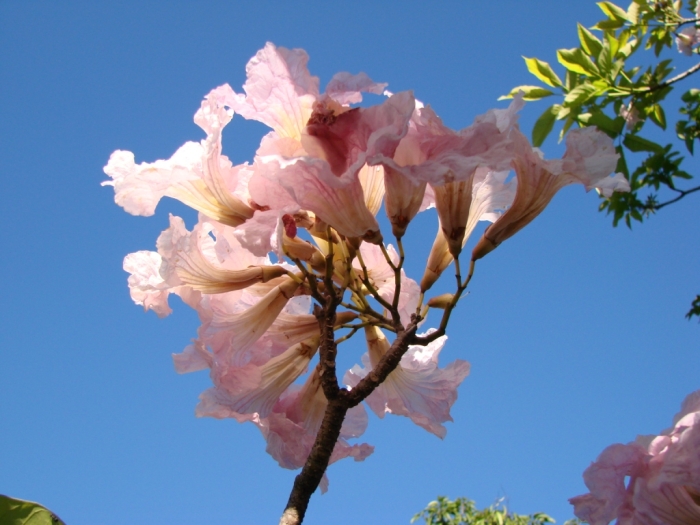Pink Trumpet Tree
(Handroanthus heptaphyllus)
Pink Trumpet Tree (Handroanthus heptaphyllus)
/
/

João Medeiros
CC BY 2.0
Image By:
João Medeiros
Recorded By:
Copyright:
CC BY 2.0
Copyright Notice:
Photo by: João Medeiros | License Type: CC BY 2.0 | License URL: https://creativecommons.org/licenses/by/2.0/ | Uploader: João de Deus Medeiros | Publisher: Flickr |























Estimated Native Range
Summary
Handroanthus heptaphyllus, commonly known as Pink Trumpet Tree, is a semi-deciduous tree native to the Atlantic Forest and Cerrado biomes of South America, particularly Brazil, Paraguay, and northern Argentina. It typically grows to a height of 20-30 feet (6-9 meters) and a width of 13-18 feet (4-5.5 meters). The Pink Trumpet Tree is renowned for its showy, tubular flowers that are predominantly pink to purple, blooming profusely in spring before the new foliage emerges. The flowering season can vary but often occurs in September, and the tree is especially attractive when it stands leafless, covered in blossoms.
The Pink Trumpet Tree is valued for its ornamental qualities, including its vibrant floral display and its ability to withstand high winds. Its strong and deep root system makes it suitable for urban planting, as it is less likely to disrupt pavements or structures. It is a popular choice for parks, squares, and public woodlands. While it prefers full sun, it can tolerate a range of soil types, provided they have medium drainage. The tree requires specific light and humidity conditions and is susceptible to frost when young, which should be considered in temperate regions. It is easily propagated by seeds, and white-flowered varieties, known as "white lapachos," are often reproduced by grafting to maintain this unique trait. Care should be taken in cultivation to protect young trees from frost and to ensure adequate light and humidity levels.CC BY-SA 4.0
The Pink Trumpet Tree is valued for its ornamental qualities, including its vibrant floral display and its ability to withstand high winds. Its strong and deep root system makes it suitable for urban planting, as it is less likely to disrupt pavements or structures. It is a popular choice for parks, squares, and public woodlands. While it prefers full sun, it can tolerate a range of soil types, provided they have medium drainage. The tree requires specific light and humidity conditions and is susceptible to frost when young, which should be considered in temperate regions. It is easily propagated by seeds, and white-flowered varieties, known as "white lapachos," are often reproduced by grafting to maintain this unique trait. Care should be taken in cultivation to protect young trees from frost and to ensure adequate light and humidity levels.CC BY-SA 4.0
Plant Description
- Plant Type: Tree
- Height: 20-30 feet
- Width: 13-18 feet
- Growth Rate: Moderate
- Flower Color: Pink
- Flowering Season: Spring
- Leaf Retention: Semi-Deciduous
Growth Requirements
- Sun: Full Sun
- Water: Medium
- Drainage: Medium
Common Uses
Bee Garden, Bird Garden, Butterfly Garden, Hummingbird Garden, Low Maintenance, Showy Flowers
Natural Habitat
native to the Atlantic Forest and Cerrado biomes of South America, particularly Brazil, Paraguay, and northern Argentina
Other Names
Common Names: Pink Tab, Lapacho Negro, Ipê-Roxo
Scientific Names: , Handroanthus heptaphyllus, Tabebuia heptaphylla, Tabebuia ipe, Tecoma ipe, Tecoma heptaphylla, Tabebuia avellanedae var. paulensis, Tabebuia eximia, Tecoma eximia, Bignonia heptaphylla
GBIF Accepted Name: Handroanthus heptaphyllus (Mart.) Mattos